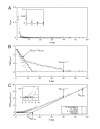Poly: a quantitative analysis tool for simple sequence repeat (SSR) tracts in DNA
- PMID: 12791171
- PMCID: PMC165442
- DOI: 10.1186/1471-2105-4-22
Poly: a quantitative analysis tool for simple sequence repeat (SSR) tracts in DNA
Abstract
Background: Simple sequence repeats (SSRs), microsatellites or polymeric sequences are common in DNA and are important biologically. From mononucleotide to trinucleotide repeats and beyond, they can be found in long (> 6 repeating units) tracts and may be characterized by quantifying the frequencies in which they are found and their tract lengths. However, most of the existing computer programs that find SSR tracts do not include these methods.
Results: A computer program named Poly has been written not only to find SSR tracts but to analyze the results quantitatively.
Conclusions: Poly is significant in its use of non-standard, quantitative methods of analysis. And, with its flexible object model and data structure, Poly and its generated data can be used for even more sophisticated analyses.
Figures


Similar articles
-
Evidence for long poly(dA).poly(dT) tracts in D. discoideum DNA at high frequencies and their preferential avoidance of nucleosomal DNA core regions.J Biomol Struct Dyn. 2006 Feb;23(4):429-46. doi: 10.1080/07391102.2006.10531237. J Biomol Struct Dyn. 2006. PMID: 16363878
-
Simple sequence repeats in different genome sequences of Shigella and comparison with high GC and AT-rich genomes.DNA Seq. 2008 Jun;19(3):167-76. doi: 10.1080/10425170701461730. DNA Seq. 2008. PMID: 18464038
-
Computational analysis of transposable element sequences.Methods Mol Biol. 2004;260:59-71. doi: 10.1385/1-59259-755-6:059. Methods Mol Biol. 2004. PMID: 15020802
-
Key-string algorithm--novel approach to computational analysis of repetitive sequences in human centromeric DNA.Croat Med J. 2003 Aug;44(4):386-406. Croat Med J. 2003. PMID: 12950141 Review.
-
Physical organisation of simple sequence repeats (SSRs) in Triticeae: structural, functional and evolutionary implications.Cytogenet Genome Res. 2008;120(3-4):210-9. doi: 10.1159/000121069. Epub 2008 May 22. Cytogenet Genome Res. 2008. PMID: 18504349 Review.
Cited by
-
Streamlining of Simple Sequence Repeat Data Mining Methodologies and Pipelines for Crop Scanning.Plants (Basel). 2024 Sep 19;13(18):2619. doi: 10.3390/plants13182619. Plants (Basel). 2024. PMID: 39339594 Free PMC article. Review.
-
Searching microsatellites in DNA sequences: approaches used and tools developed.Physiol Mol Biol Plants. 2012 Jan;18(1):11-9. doi: 10.1007/s12298-011-0098-y. Epub 2011 Dec 23. Physiol Mol Biol Plants. 2012. PMID: 23573036 Free PMC article.
-
Homopolymer tract length dependent enrichments in functional regions of 27 eukaryotes and their novel dependence on the organism DNA (G+C)% composition.BMC Genomics. 2004 Dec 14;5:95. doi: 10.1186/1471-2164-5-95. BMC Genomics. 2004. PMID: 15598342 Free PMC article.
-
PolyMorphPredict: A Universal Web-Tool for Rapid Polymorphic Microsatellite Marker Discovery From Whole Genome and Transcriptome Data.Front Plant Sci. 2019 Jan 11;9:1966. doi: 10.3389/fpls.2018.01966. eCollection 2018. Front Plant Sci. 2019. PMID: 30687361 Free PMC article.
-
Characterization of Simple Sequence Repeats (SSRs) in Ciliated Protists Inferred by Comparative Genomics.Microorganisms. 2020 May 1;8(5):662. doi: 10.3390/microorganisms8050662. Microorganisms. 2020. PMID: 32370063 Free PMC article.
References
-
- Streisinger G, Okada Y, Emrich J, Newton J, Tsugita A, Terzaghi E, Inouye M. Frameshift mutations and the genetic code. Cold Spring Harb Symp Quant Biol. 1966;31:77–84. - PubMed
-
- Kunkel TA, Soni A. Mutagenesis by transient misalignment. J Biol Chem. 1988;263:14784–14789. - PubMed
-
- Marx KA, Hess ST, Blake RD. Characteristics of the large (dA).(dT) homopolymer tracts in D. discoideum gene flanking and intron sequences. J Biomol Struct Dyn. 1993;11:57–66. - PubMed
MeSH terms
Substances
LinkOut - more resources
Full Text Sources
Other Literature Sources

